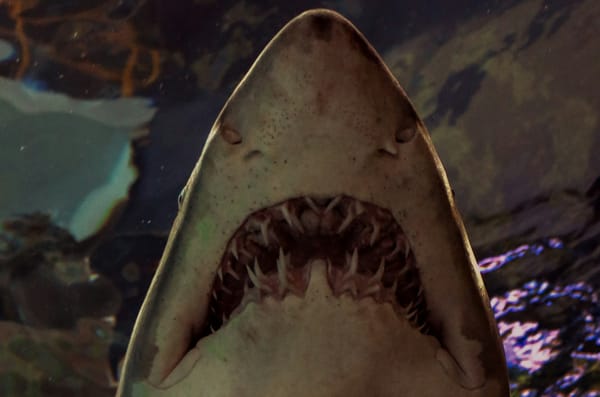The Frog Pond #2: The Blob
Or, I am both amazed and horrified by The Ridiculously Resilient Ridge and its Blob.

Welcome to a new year, and a new instalment of The Frog Pond! If this is your first, I recommend checking out The Frog Pond #1 to understand how you came to find this pond, and how it first welcomed you.
A return to the pond
On a bitterly cold day, the forest path diverges before you. Again, you turn left instead of right. Frost has covered the dirt, roots, and rock as you approach, and yet the pond remains unfrozen. You set your bags and your worries down beside you and sit at the edge, the laps of the water tickling at your boots.
This month’s pond session is hopeful, resilient, and ready to tackle the year ahead.
Mist-erious knowledge
Despite the chill in the air, and in your lungs, warm mist once again clings to the pond’s surface. For a second you swear you see something small hop within its form and onto a lilypad. Then they disappear within the haze as the mist reaches forward.
You reach out your hand eagerly. When your fingers touch the mist, you are filled with mist-erious knowledge.
Did you know that the pacific ocean had a Blob that was too warm?
The Blob (the scientific term!) was a gigantic patch of the Pacific Ocean, spanning off the coast of Alaska all the way down to Mexico, that was unseasonably warm. It was first detected in 2013 and lasted until 20161. Literally a huge blob of water in the ocean that was too warm, it caused wide-spread issues for marine life and contributing to huge weather events across North America.
What created The Blob?
While not a mad scientist, the originator of The Blob does have an impressive title. A persistent high-pressure ridge nicknamed The Ridiculously Resilient Ridge2 (yes! really!) was an anticyclone off the California coast that, among other things, impacted the 2011-17 droughts. This atmospheric ridge blocked south/west weather systems from entering the area, creating a high-pressure system that shifted incoming winds northward, through colder climates, and contributed to the “Polar Vortex” that you may have heard of over the past few years across North America3. (And, after initially drafting this newsletter in mid-December, appears to now have happened again this year.)
So California got too dry, the East Coast got too cold, and The Blob was formed due to the consistent lack of cooler systems that normally passed through/over it.
How warm are we talking here?
This huge patch of water (reaching up to 1,000 miles (1,600 km) long, 1,000 miles (1,600 km) wide, and 300 feet (91 m) deep in 20144) was only 1 to 4 degrees Celsius warmer than usual5. But just this tiny difference meant that the water held fewer nutrients and affected marine life, including fish, birds, and seals along the Pacific coast of North America.
Return of The Blob
Since the original Blob has dissipated, smaller Blobs have taken up the Pacific warmth's reins. The Blob 2.06 (again! the scientific term!) appeared in 2019 and The Southern Blob7 appeared in 2021 near New Zealand.
But, like most sequels, these blobs were weaker versions of the first, but still created big disruptions in the ecological waterscape.
A chilly challenger appears!
There was ALSO an opposite blob: The Cold Blob (also called, for some reason, the "North Atlantic Warming Hole"??8) was a temperature anomaly in the North Atlantic in 2015-16 during an otherwise global record-breakingly warm year since 18809. The origin of The Blob's colder cousin to the East is theorized to have been melting ice sheets from Greenland10 .
This all brings me to wonder…
In your storytelling, how do you use disruptions, whether as big as an ocean or as small as a frog pond, to impact your story?
(Also, my lovely writing friend Hester, while listening to me rant about all of the above, shared an amazing Blob-related song (sound warning: video link) that I must pass on.)
A word from a passing frog
Happy New Year! I’m wishing you creativity, luck, and perseverance for 2023.
Querying
I’m well and truly into the query trenches now! I’ve submitted to 29 agents and received a full request (exciting!), a partial request (since rejected), and 17 rejections. This is encouraging for my first couple batches of queries ever! My goal is to submit this book (nicknamed Lighthouse, my adult gothic horror novel) to at least 100 agents, so that will continue into the new year! I’m proud of how I’m faring so far in an ego-bruisingly vulnerable stage of the writing/publishing process and excited for what the new year may hold!
Writing
I tried to focus on my adult thriller, AKA Bachelor Hell, in November. But while I set up some good foundations for the characters, researched my heart out, and all the fun pre-writing bits—honestly, it’s been stalled for weeks. So I used the holiday break while I’m home with family to get some distance, let it (and me) breathe, and see if any new ideas came about.
And did it ever. I was less than 12 hours into my “take a break” decision, finally giving my brain a little peace of mind (ha), when I was practically smacked in the face with a new book idea. Nearly fully formed, I knew the start and end and stakes and setting, I could barely type fast enough to get the ideas down!!
So, if you’re looking for a sign to take your breaks, this is it. While my break ended up being less than a day, it was the act itself of shrugging off the anxiety of a project that wasn’t working which gave me the space to enjoy something new.
I’m excited to return to my adult thriller after this project (nicknamed Hellmouth WIP, another adult gothic horror), but for now, I’m having a ball with this new book (a sneak peek of the concept here!).
TL;DR: I’m following some sage advice I found on the internet once:

Reading
I wrapped up my 35th read of 2022 with BABEL by R. F. Kuang. In short: I loved it. I haven’t read many dark academia books, but Babel, being an adult historical fantasy dark academia novel, was a perfect version of the genre for me. Sharp, geeking out about linguistics, and full of character-centred critiques of academic and imperial colonialism. I highly recommend the novel, especially if you’re new to the dark academia genre!
(If anyone has recommendations for other dark academia novels they loved, YA or Adult, please let me know!)
My first read of 2023 will be HALF A SOUL by Olivia Atwater on recommendation from a friend that it is “Pride and Prejudice x Howl’s Moving Castle x Bridgerton” which, hell yes, sign me up!
And more generally, I’m going to up my GoodReads challenge for 2023 from last year’s 25 (which I reached and surpassed!) to 35. I could not be more grateful for audiobooks as a format, and for libraries as a source. Libraries have granted me the space to try so many more books than I could have justified buying on a limited budget. If you’ve never looked into it, I definitely recommend checking what kinds of online databases your local library might have!
A prompt on a lilypad
You return from the mist, back to the edge of the pond, only to find a lilypad floating where before lay only still water. A ripple creates a trail from the green lip of the water flower and towards the centre of the lake. Is that a croak in the distance?
On the lilypad is a note. You reach out, and it reads:
What kinds of systems do you use in your stories? Natural (weather, seasons, ecosystems), social (governments, friendships, languages), cultural (religious, artistic, technological), etc.?
How do these systems work? How do they fail? Who gains from them? Who is hurt by them?
What stresses are put on the systems, and how does that shape your plot, characters, stakes, and conflict?
You stand up from the pond’s edge. Dust off the snowflakes that have landed on your coat’s shoulders. There are responsibilities and joys to get on with. Fires to tend, family to love, words to write. The world keeps moving, even if the frog pond stays quiet, strange, and weirdly wonderful.
But maybe you’ll turn left again, the next time you go walking.
Footnotes
1 https://www.earthdata.nasa.gov/learn/sensing-our-planet/blob
2 https://weatherwest.com/archives/1021
3 https://www.ncbi.nlm.nih.gov/pmc/articles/PMC4820386/
4 https://www.sciencedaily.com/releases/2015/04/150409143041.htm
5 https://news.agu.org/warm-blob-in-pacific-ocean-linked-to-weird-weather-across-the-u-s-2/
6 https://www.ncbi.nlm.nih.gov/pmc/articles/PMC7171163/
7 https://journals.ametsoc.org/view/journals/clim/34/18/JCLI-D-20-0886.1.xml
8 https://www.sciencedaily.com/releases/2019/04/190415143955.htm





